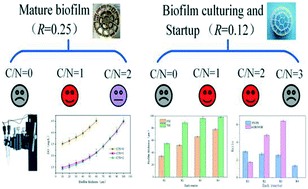Effect of C/N on partial nitrification in an MBBR at low temperature
Abstract
Two main problems in partial nitrification at low temperature are its difficult start-up and easy inhibition, and this issue significantly limits the broad application of advanced partial nitrification technology. To promote rapid culturing and stabilization of partial nitrification biofilms, two experiments were carried out to investigate the influence of C/N on partial nitrification through ratio control (R, dissolved oxygen (DO)/effluent total ammonia nitrogen (TANeff)) in a lab-scale moving bed biofilm reactor (MBBR) at 12 °C. One experiment looked at the effect of C/N on the stable operation of partial nitrification at 12 °C, which inoculated a mature biofilm with good partial nitrification performance; the other looked at the effect of C/N on the biofilm cultivation and start-up of partial nitrification at 12 °C, which inoculated activated sludge and Pall rings. As for the startup experiments, only the C/N ratio was investigated, as the DO/TANeff ratio was kept constant. The effect of C/N on the mature partial nitrification biofilm showed that the increase of C/N could increase the resistance of partial nitrification to high DO. The nitrite accumulation ratio (NAR, (NO2−-N/(NO2−-N + NO3−-N) × 100%)) increased from 40.41% to 98.78% when R was 0.25 and C/N increased from 0 to 1. Meanwhile, when C/N increased to 2 and the R value slightly increased to 0.3, partial nitrification failed. The penetration of DO in the biofilm indicated that the increase of C/N enhanced the mass transfer resistance of DO, but it was similar when C/N was 1 and 2. Adding an appropriate amount of C/N can reduce the negative effect of partial nitrification damage caused by DO/TAN enlargement. The start-up experiment showed that C/N = 1 and C/N = 2 were essential for culturing biofilms and achieving partial nitrification at 12 °C, which can be successfully achieved (NAR was 85% and 96%) on the 56th and 52nd days. Neither C/N = 0 nor C/N = 3 could effectively achieve the partial nitrification. The increase of C/N will reduce the proportion of nitrifying bacteria in the biofilm, which is harmful to the partial nitrification. This will also lead to the decrease of protein/polysaccharide (PN/PS) and affect the stability of the biofilm.



 Please wait while we load your content...
Please wait while we load your content...